
SB Media
Physics of the cosmos 🪐🔭
Keep the curiosity alive! 🫡
✉️[email protected]
[DM-Credit/Removal]
Recent Posts

An elastic collision is a type of collision where both momentum and kinetic energy are conserved. This means that after two objects collide, they bounce off each other with no loss of energy to heat, sound, or deformation. Instead, the energy is transferred cleanly from one object to another. We can see a clear example of this in a well-known physics demonstration involving two suspended bowling balls. In this setup, one ball is pulled back and released. It swings forward, collides with the second ball and stops. Then, the second ball swings away with nearly the same speed. This is a near-perfect elastic collision: momentum and energy move through the system without loss (there is energy loss in sound, heat, and friction, but let's think it is done in a perfect vacuum). Another example is the Newton’s Cradle. Pull one ball back, and only the ball on the opposite end moves after it hits. The balls in the center are transferring the energy and momentum. Both examples are tied directly to Newton’s Third Law: For every action, there is an equal and opposite reaction. When one object pushes on another, the second pushes back with equal force in the opposite direction. In an elastic collision, this law (along with the conservation of momentum) explains why energy is transferred so efficiently and symmetrically. --- 💡 Learn More: Elastic Collisions - Britannica https://www.britannica.com/science/elastic-collision [Sources] (🎞 Dan Burns) (🎞 Physics Demos) (🎞 Teacher Source) (🎼 Untitled#13 - glwzbll) (✍️ Description) 1. The Physics Classroom (2023). Momentum and Collisions. 2. American Association of Physics Teachers – Demo Collection. --- Follow @science.sbmedia to keep the curiosity alive! 🪐🔭 #ElasticCollision #BowlingBallPhysics #NewtonsCradle #MomentumTransfer #PhysicsInAction #STEM #EnergyConservation #ScienceExplained #DanBurns #ClassroomDemo
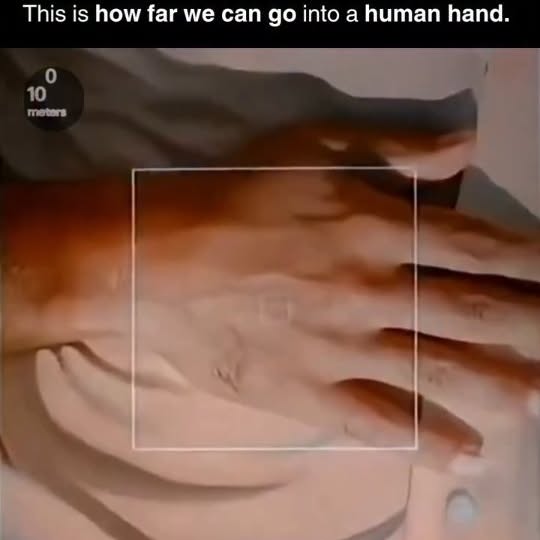
🔍 (10⁰ m) The Hand: A regular human hand, about 10 cm wide. Just skin, lines, and hair. 🔍 (10⁻¹ m) Surface Details: You start to see skin texture, pores, and maybe a tiny hair follicle. 🔍 (10⁻² m) Skin Cells: Individual cells begin to appear flat, tile-like structures forming the epidermis. 🔍 (10⁻³ m) Cell Structures: You can distinguish the nucleus, the cell membrane, and the bustling activity inside. 🔍 (10⁻⁴ to 10⁻⁵ m) Organelles: We pass through membranes and enter the nucleus. There are chromosomes and DNA strands beginning to unfold. 🔍 (10⁻⁶ m) DNA: Here we see double-helix DNA, about 2 nanometers across. It’s tightly coiled and packed with genetic instructions. Life’s blueprint. 🔍 (10⁻⁷ to 10⁻⁸ m) Molecules: Molecular structures appear: proteins, enzymes, and carbon-based compounds. You can see atoms beginning to line up into bonds. 🔍 (10⁻¹⁰ to 10⁻¹¹ m) Atoms (Carbon Atom): Now we see individual atoms. A carbon atom stands out, common in organic molecules. Electrons form a cloud around a dense center the nucleus. 🔍 (10⁻¹⁴ to 10⁻¹⁵ m) Atomic Nucleus: We zoom past the electron cloud and reach the nucleus, incredibly small, around 1 femtometer. It holds protons and neutrons, and nearly all the atom’s mass. 🔍 (10⁻¹⁶ to 10⁻¹⁸ m) Quarks and Gluons Field: Quarks interact within protons/neutrons and are held by gluons. 🔍 (10⁻²⁰ meters) Quantum Fluctuations: On scales of 10^-20 meters, temporary particles emerge from the vacuum due to energy fluctuations. Powers of Ten (1977) by Charles and Ray Eames, this scale dive takes us from the visible to the fundamental building blocks of reality. --- 💡 Learn More: How big is a human? - Scale of the Universe https://scaleofuniverse.com/en/universe/human [Sources] (🎞 Powers of Ten™ (1977) – Eames Office/YT) (🎼 Red Sex - Vessel) (✍️ Description) 1. Eames, C. & Eames, R. (1977). Powers of Ten. IBM/Eames Office. --- Follow @science.sbmedia to keep the curiosity alive! 🪐🔭 #PowersOfTen #ScaleOfTheUniverse #ZoomInPhysics #QuantumFoam #SubatomicWorld #ScienceExplained #STEM #Nanoworld #Zoom #Physics
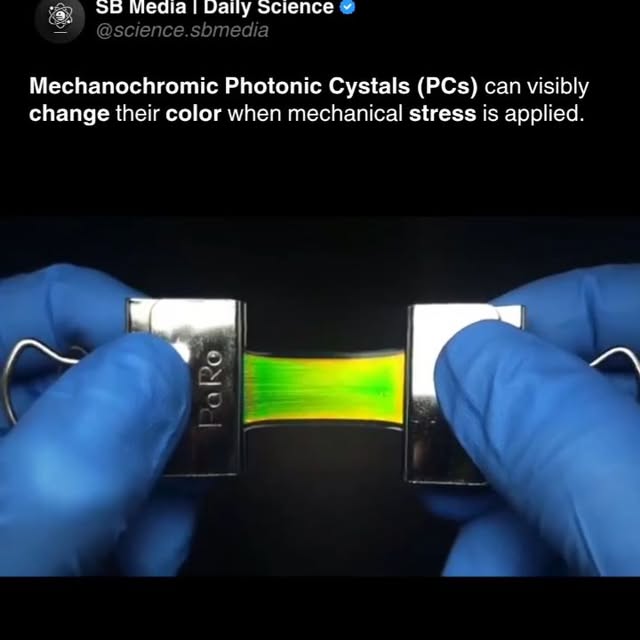
Some specially engineered materials, like certain crystals or elastomers (rubbery substances), can visibly change their color when mechanical stress is applied. This happens because the molecular structure of the material itself shifts under pressure or tension, altering the way it interacts with light. At the microscopic level, these materials are built with molecules that are sensitive to force. When you stretch them, their internal arrangement changes: ▪︎ In some cases, this changes the spacing of nanostructures that reflect specific wavelengths of light. ▪︎ In others, the force might break or twist chemical bonds in a way that changes how light is absorbed. In both cases, the result is a visible shift in color that’s reversible when the stress is released. Scientists and engineers are exploring mechanochromic materials for a variety of applications: ▪︎ Wearable stress sensors in sports and medicine ▪︎ Damage detection in aerospace materials ▪︎ Smart textiles that respond to motion or pressure. These materials give us a direct, visual way to understand forces at work, making invisible stress become visible to the human eyes. --- 💡 Learn More: Mechanochromic Palettes of Cholesteric Liquid Crystal Elastomers for Visual Signaling - AOM https://www.researchgate.net/publication/379971012_Mechanochromic_Palettes_of_Cholesteric_Liquid_Crystal_Elastomers_for_Visual_Signaling [Sources] (🎞 Advanced Optical Materials) (🎼 BRODYAGA FUNK - Eternxlkz) (✍️ Description) 1. Park, Hyewon, et al. (2024). "Mechanochromic Palettes of Cholesteric Liquid Crystal Elastomers for Visual Signaling. 2. Lee, J., Kim, H., Jang, J., Choi, M., & Jeong, U. (2020). Stretchable mechanochromic materials and devices for healthcare and soft robotics. --- Follow @science.sbmedia to keep the curiosity alive! 🪐🔭 #Mechanochromism #SmartMaterials #ColorChangingPolymers #NanoScience #MolecularPhysics #InvisibleForces #ScienceExplained #STEM #MaterialScience #PhysicsInColor

Sonoluminescence is a phenomenon where ultrasound waves in a liquid create tiny bubbles that collapse violently, emitting brief flashes of light. When a powerful acoustic wave moves through a liquid, it generates cavities (or bubbles) through a process called cavitation. These bubbles grow and then collapse rapidly, generating temperatures as high as 10,000°C and even more. At that moment, electrons are stripped from atoms, forming a plasma, and (from that plasma) a burst of light is emitted. The effect was first observed in 1934 by H. Frenzel and H. Schultes in Germany while testing sonar. But, it wasn’t until the 1980s that D. Felipe Gaitan and Lawrence Crum managed to stabilize a single bubble emitting light repeatedly. In 2005, D. Flannigan’s team measured the extreme temperatures inside these bubbles, verifying values near 15,000 K, possibly more (though higher estimates remain unconfirmed). The flashes last just tens to hundreds of microseconds, and the glowing bubbles are only about a micrometer wide. This is like a burst of cosmic-scale energy in a tiny droplet of water. Some researchers (like Rusi Taleyarkhan) have suggested that these bubble collapses might reach conditions for nuclear fusion, calling it "bubble fusion" or sonofusion. His experiments showed signs of tritium and neutron production, but results remain controversial and have not been reliably reproduced by independent teams. --- 💡 Learn More: Sonoluminescence - ScienceDirect https://www.sciencedirect.com/topics/physics-and-astronomy/sonoluminescence [Sources] (🎞 Research and Didactical Videos - Alessio GUARINO/YT) (🎼 Gravitational Forces - ITG Studios) (✍️ Description) 1. Frenzel, H. & Schultes, H. (1934). Initial discovery at University of Cologne. 2. Flannigan, D.J., & Suslick, K.S. (2005). Emission temperatures from single-bubble sonoluminescence. Nature. 3. Taleyarkhan, R. et al. (2002). Evidence for Nuclear Emissions During Acoustic Cavitation. Science, 295(5556), 1868. --- Follow @science.sbmedia to keep the curiosity alive! 🪐🔭 #Sonoluminescence #BubbleFusion #PhysicsExplained #AcousticCavitation #MiniStar #ExtremeTemperatures #ScienceExplained #SoundAndLight #STEM
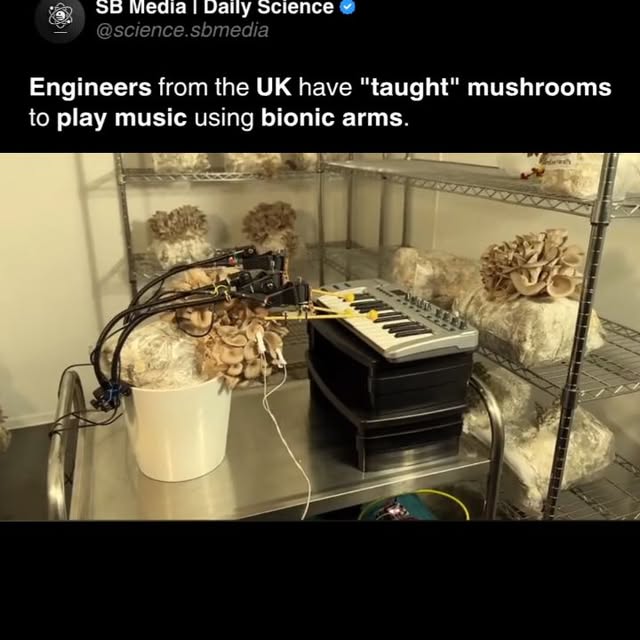
Jon Ross and Andy Kidd, engineers and artists from the UK, have developed a system that lets mushrooms and plants play music through bionic arms. John, the visionary behind Bionic and the Wires, combines art, technology, and environmental thinking to create custom bionic arms that enable plants and fungi to produce music and visual art, challenging traditional human-centered notions of creativity by empowering non-human lifeforms to express themselves. Complementing this, Andy, a skilled electronic musician and live performer, transforms bio-signals from nature into immersive soundscapes using synthesizers and digital tools, bridging the organic and technological realms. Together, their innovative collaboration pushes the boundaries of art and redefines who (or what) can be an artist. Their project merges biology, robotics, and creativity, turning natural bioelectric signals into expressive performances and here’s how they describe it: “We connect bionic arms to mushrooms and plants so they can play music and be creative. Our art explores new ways of thinking about the natural world. All life create bio-electrical signals. Our equipment converts these into signals that are used to control the arms. Recent research suggests that fungi and plants exhibit surprising levels of intelligence, including decision-making, learning, memory and the ability to respond to sound waves.” --- 💡 Learn More: Bionic and The Wires https://bionicandthewires.com/ [Sources] (🎞 @bionicandthewires) (🎼 Mushroom) (✍️ Description) 1. Jon R. & Andy K. (2024) Bionic and The Wires. --- Follow @science.sbmedia to keep the curiosity alive! 🪐🔭 #BionicMusic #PlantNeurobiology #FungalIntelligence #Bioelectricity #BionicAndTheWires #LivingInstruments #OrganicTech #ScienceExplained #STEM #NatureAndMachines

"Track Buckling" aka "Sun Kink", is caused by thermal expansion, a natural property of materials that expand when heated. As the air temperature rises, steel rails can heat up to 50°C (122°F) and much more. Since steel expands when it gets hot, and rails are often held rigidly in place, the built-up thermal stress has nowhere to go. Instead of growing longer, the track buckles laterally usually at its weakest or most flexible point. 📐 Thermal expansion (ΔL) is described by: ΔL = α × L × ΔT α – thermal expansion coefficient for steel L – original rail length ΔT – temperature rise Even a small temperature increase over a long distance creates substantial internal forces. When compressive stress exceeds what the track can withstand, the rail suddenly bends, creating the dangerous wave-like kinks seen in extreme heat. ⚠️ Track buckling can derail trains. That’s why rail networks: ▪︎ Use expansion joints or breather switches ▪︎ Apply long welded rail with pre-set tension ▪︎ Monitor and restrict train speeds during heatwaves ▪︎ Install track-side thermometers and automated warning systems In places like the southern U.S., Australia, Africa or India, rail heat safety protocols are standard. Sun kinks are rare, but when they happen, they’re no joke and very expensive to fix. --- 💡 Learn More: Sun Kinks in Railways - SciAm https://www.scientificamerican.com/article/sun-kinks-in-railways-join-the-list-of-climate-change-s-toll/ [Sources] //By Appearance// (🎞 Mariana Garcia-Serrato/YT) (🎞 Rod Williams/YT) (🎞 N-TL New Technologies/YT) (🎼 Untitled#13 – glwzbll) (✍️ Description) 1. Network Rail (2022). Thermal Expansion and Rail Buckling. 2. Beer, F.P. & Johnston, E.R. (2015). Mechanics of Materials. --- Follow @science.sbmedia to keep the curiosity alive! 🪐🔭 #SunKink #TrackBuckling #ThermalExpansion #PhysicsInEngineering #RailroadSafety #HotWeatherTrains #TrainTracks #ScienceExplained #STEM #HotRails
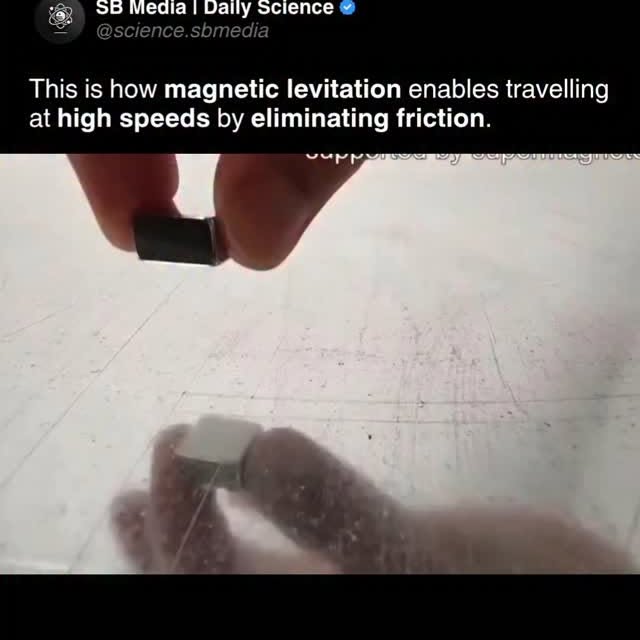
Magnetic levitation, whether in a science demo or a high-speed train, relies on the same core idea: using magnetic fields to fight gravity. Magnets can repel or attract without contact, and with the right setup, they can suspend objects in mid-air. The real challenge is stability. Maglev trains solve this using electromagnets and sensors that constantly adjust the magnetic force, allowing the train to float smoothly just above the track. This system removes friction and enables speeds over 600 km/h. The floating disk in the demo shows quantum levitation. It uses a type-II superconductor, cooled with liquid nitrogen, placed over a magnetic track. Two quantum effects come into play: the Meissner effect, which pushes magnetic fields out, and flux pinning, which locks magnetic field lines inside. Together, they hold the superconductor at a fixed height and orientation. It is levitating but also perfectly stable. While Maglev trains don’t use quantum effects, the visual and physical principles are similar. Both rely on magnetic forces to lift and move without friction. The superconductor demo makes the invisible forces behind Maglev visible, showing how we can float heavy objects with no contact while turning what looks like science fiction into real-world technology. --- 💡 Learn More: How Maglev Trains Work - How Stuff Works https://science.howstuffworks.com/transport/engines-equipment/maglev-train.htm [Sources] (🎞 Magnetic Games) (🎞 Real Engineering) (🎞 Central Japan Railway Company) (🎼 Untitled#13 – glwzbll) (✍️ Description) 1. Hsu, J. (2011, October 18). Quantum levitation demonstrated with superconductors. IEEE Spectrum. 2. Powell, J. (2002). Maglev: Magnetic Levitation Transportation Systems. Springer. --- Follow @science.sbmedia to keep the curiosity alive! 🪐🔭 #QuantumLevitation #MaglevTrains #Superconductors #MeissnerEffect #FluxPinning #MagneticLevitation #FrictionlessMotion #ScienceExplained #STEM #FutureTransport
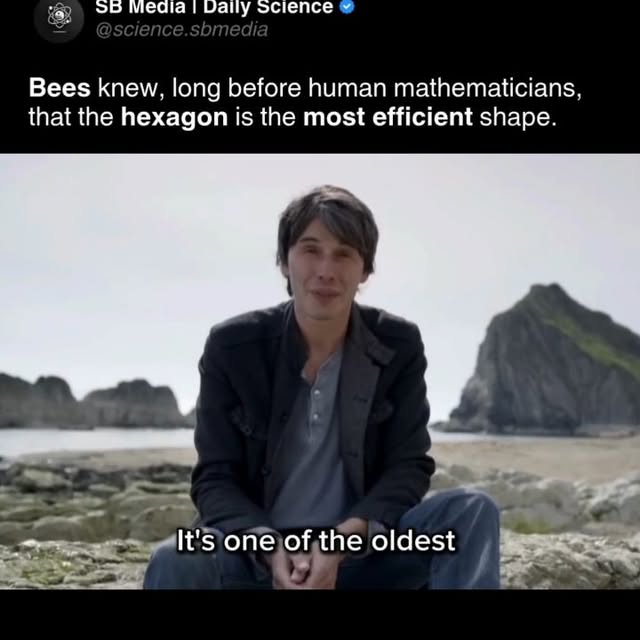
When bees build their wax cells, they initially form soft circular tubes. Then, it is thought that as the wax softens from their body heat, physics and surface tension reshape them into perfect hexagons. This may sound simple, but it left mathematicians wondering for centuries ans it wasn't until 1999 that Thomas C. Hales finally proved the Honeycomb Conjecture, which asks: “What’s the most efficient way to divide a flat surface into equal areas with the least total perimeter?” His proof, using a lot of complex math like discrete and computational geometry, showed that no other shape (not triangles, not squares, not circles) can match hexagons in this balance of space and boundary. P.S.: I could listen to Brian Cox talk for hours and never get tired. --- 💡 Learn More: The Honey Comb Conjecture - Article https://link.springer.com/article/10.1007/s004540010071 [Sources] (🎞 Forces of Nature with Brian Cox: Ep1 - BBC) (🎼 Can You Hear The Music - Ludwig Goransson) (✍️ Description) 1. Hales, T.C. (2001). The Honeycomb Conjecture. Discrete & Computational Geometry. 2. Scientific American (2013). Hexagons in Nature. --- Follow @science.sbmedia to keep the curiosity alive! 🪐🔭 #HoneycombConjecture #BeeMath #HexagonEfficiency #NaturalGeometry #ThomasHales #PhysicsOfBees #ScienceExplained #STEM #HexagonsEverywhere

When someone very briefly touches molten metal with a sweaty/wet hand, the extreme heat causes the moisture to vaporize instantly, creating a thin, protective layer of steam between the skin and the liquid metal. This layer acts like a thermal shield, preventing direct contact for a fraction of a second, just long enough to avoid damage. And because molten metals have high surface tension, they naturally resist sticking to the skin, which further limits heat transfer. Also heat takes time to propagate to the hand, which is probably the main reason for the result shown. This phenomenon is known as the Leidenfrost effect, named after Johann Gottlob Leidenfrost, who described it in 1756: It occurs when a liquid comes in contact with a surface much hotter than its boiling point, typically above 200 to 250°C (392 to 482°F) for water. Instead of boiling away instantly, the liquid forms a cushion of vapor that insulates it from the hot surface. This vapor layer greatly reduces heat transfer because steam is a poor conductor of heat compared to liquid water or solid contact. In the context of molten metal, which can be above 1000°C (1832°F), the sweat or moisture on the skin instantly vaporizes, generating this vapor barrier. ⚠️ This is incredibly dangerous. Without the right speed and timing the result is instant third-degree burns. --- 💡 Learn More: Leidenfrost Phenomenon - ScienceDirect https://www.sciencedirect.com/topics/engineering/leidenfrost-phenomenon [Sources] (🎞 Unbelievable Videos/YT) (🎼 particles (slowed) - villiam lane) (✍️ Description) 1. Leidenfrost, J.G. (1756). De Aquae Communis Nonnullis Qualitatibus Tractatus. --- Follow @science.sbmedia to keep the curiosity alive! 🪐🔭 #LeidenfrostEffect #MoltenMetal #HeatTransfer #ThermalPhysics #PhysicsDemo #SurfaceTension #SteamShield #ScienceExplained #STEM
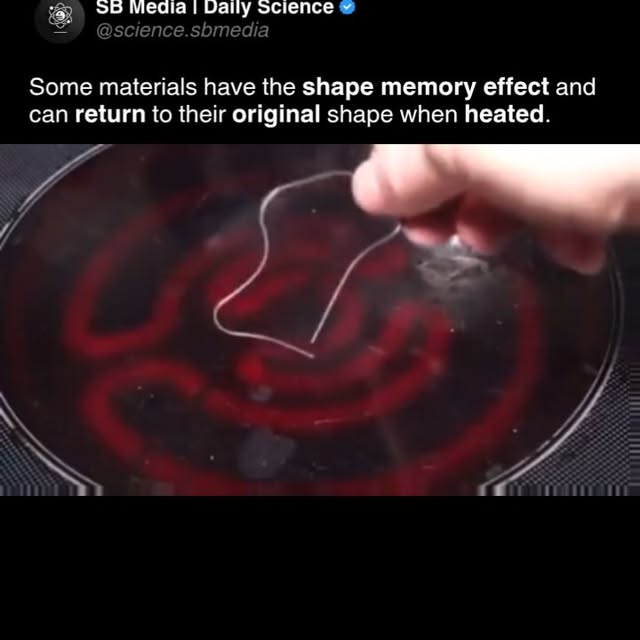
Shape Memory Alloys (SMAs) are a special class of metal alloys, like Nitinol, that can be bent and deformed when cold, but snap back to a programmed shape when heated. From a physics perspective, this happens because of a solid-state phase transformation between two crystal structures: martensite (soft) and austenite (rigid). When the alloy is cold, it enters the martensite phase: flexible, low-symmetry structure that allows bending without permanent atomic rearrangement. When heated, it transitions to the austenite phase: more ordered and stable and triggers the atoms to rearrange into their pre-trained shape. The effect is driven by thermodynamics or Gibbs free energy minimization. This is like saying that the paperclip and the spring "want" to return to the shape that takes the least energy to exist in. 🔧 To train or program an SMA: 1. Heat it into the austenite phase 🔥 2. Form it into the desired shape 📎 3. Hold it at that temperature for several minutes ⏰️ 4. Cool it down to lock in the “memory” ❄️ Next time it’s reheated, it will return to that shape. --- 💡 Learn More: Shape Memory Materials Open Doors for Smart Tech - NASA https://technology.nasa.gov/Shape%20Memory%20Materials%20Open%20Doors%20for%20Smart%20Tech [Sources] (🎞 Reddit) (🎼 Dust - Hans Zimmer) (✍️ Description) 1. Otsuka, K., & Wayman, C.M. (1998). Shape Memory Materials. 2. Liu, Y. et al. (2005). Thermodynamics of Phase Transformation in Nitinol. --- Follow @science.sbmedia to keep the curiosity alive! 🪐🔭 #ShapeMemoryAlloy #Nitinol #SmartMaterials #Martensite #Austenite #MaterialScience #PhysicsExplained #STEM #MemoryMetal

When you spin a fully expanded Hoberman Sphere, it rotates slowly. But if you collapse it mid-spin, the rotation speeds up dramatically. First we need to know that momentum measures how difficult it is to stop a moving object and it depends on the object's mass and velocity: ▪︎ Linear momentum refers to straight line motion (a tennis ball is easier to stop than a bowling ball). ▪︎ Angular momentum applies to spinning objects and depends on mass and angular velocity (a coin flip is easier to stop than a spinning carousel) Then, with the Hoberman Sphere, this change of speed can be explained with the conservation of angular momentum: in a closed system, angular momentum (L) must stay conserved. The equation is "L = I × ω" ▪︎ I = moment of inertia (how mass is spread out) ▪︎ ω = angular velocity (how fast it spins) When the sphere is expanded, its mass is farther from the center, so the moment of inertia (I) is larger and the angular velocity (ω) is smaller. When the sphere is collapsed, its mass is now closer to the center, so (I) gets smaller, and (ω) increases in order to keep the angular momentum (L) constant. --- 💡 Learn More: Conservation of Angular Momentum - Britannica https://www.britannica.com/science/conservation-of-angular-momentum [Sources] (🎞 Utah State University - Physics Demos) (🎼 particles (slowed) - villiam lane) (✍️ Description) 1. Hoberman Designs – Mechanical Expansion Models. 2. University Physics Volume One. Conservation of Angular Momentum. --- Follow @science.sbmedia to keep the curiosity alive! 🪐🔭 #AngularMomentum #HobermanSphere #NeutronStars #PhysicsInMotion #MomentOfInertia #SpinningObjects #ScienceExplained #STEM #Astrophysics #ConservationLaws
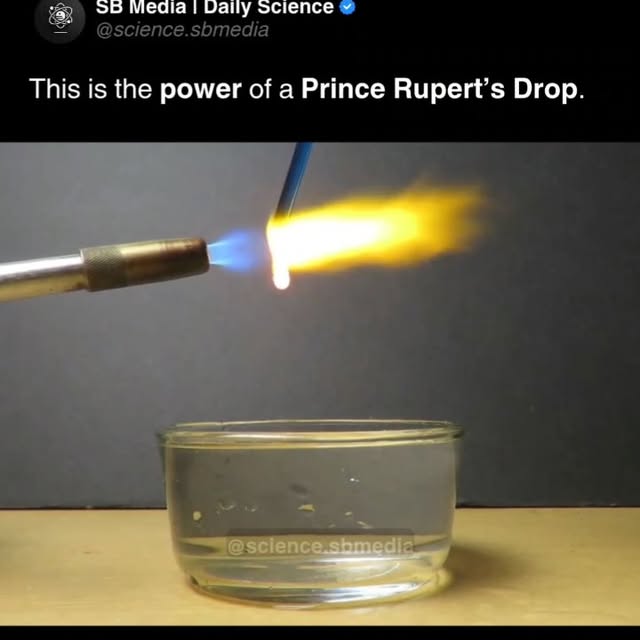
A Prince Rupert’s Drop is made by dripping molten glass into cold water, which rapidly cools and solidifies the outer layer while the inner core cools more slowly. This sudden difference in cooling rates locks in extreme internal stresses. The result is a glass object with unique properties: the bulbous head is strong enough to withstand hammer blows or even some small caliber bullets. But the thin tail, if slightly cracked, triggers a chain reaction that causes the entire drop to explode into powder in milliseconds. The fracture wave travels faster than the speed of sound in glass (~1,500–5,000 m/s). This behavior is explained by several key physics principles: ▪︎ Thermal Stress and Quenching: The outer layer cools and hardens fast, creating compressive stress, while the inner part cools slowly and shrinks, creating tensile stress. This internal tension gives the drop its unique mix of strength and fragility. ▪︎ Fracture Propagation: The head is tough due to compressive stress, making it hard to crack. But the tail holds tension, so even a tiny break releases all the stored energy in a violent, chain-reaction shatter. ▪︎ Brittle vs. Ductile Failure: Glass is a brittle material so it doesn’t deform, it just breaks. The drop is an example of how structural integrity depends on internal stress patterns, and not just the material itself. This experiment was named after Prince Rupert of the Rhine, a 17th-century German-English soldier and scientist who introduced these glass curiosities to King Charles II of England. They became a sensation at royal courts and science salons as a physical oddity until today. --- 💡 Learn More: Prince Rupert’s Drop - The Royal Society https://royalsocietypublishing.org/doi/10.1098/rsnr.1986.0001 [Sources] (🎞 Rupert Drop Guy) (🎞 Smarter Everyday) (🎞 Crazy Hydraulic Press) (🎼 Untitled#13 - glwzbll) (✍️ Description) 1. Gorham, D. et al. (1996). Residual Stresses in Tempered Glass Structures. 2. Royal Society Archives. Prince Rupert and 17th-Century Science. --- Follow @science.sbmedia to keep the curiosity alive! 🪐🔭 #PrinceRupertsDrop #TemperedGlass #GlassPhysics #ExplodingGlass #
Similar Influencers

Quantum Computing & Tech ⚛️

Prompted | Intelligenza Artificiale


Growth Forge AI

AI Strategies | Business Growth

Awakened Truths

CNET

Quantum | Agência de resultado
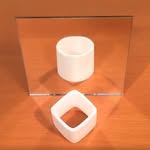
Physics Funny

the calculus guy

Rachel Barr | Neuroscientist

TECtalks

𝐂𝐡𝐢𝐩𝐮𝐥𝐚𝐫𝐢𝐭𝐲 ™ | 𝐓𝐞𝐜𝐡𝐧𝐨𝐥𝐨𝐠𝐲 | 𝐘𝐨𝐮𝐫 𝐄𝐝𝐠𝐞

Early Startup Days

Taylor Perkins (Cult Daddy)

Space Cameo

Nobel Prize

SCIENCE & TECHNOLOGY

Sinéad Bovell

Nathan Hodgson

AI Folks

Startup Archive

Space | universe | knowledge

Billy Carson

BBC News

David Marsh | Space for Earth

Lucio Arese
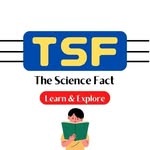
The Science Fact
NPR
